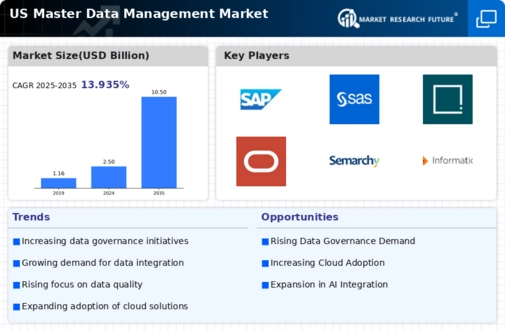Adoption of Advanced Analytics
The rise of advanced analytics tools is reshaping the master data-management market, as organizations seek to derive actionable insights from their data. With the increasing availability of big data, companies are turning to analytics to inform decision-making processes. This trend is evident in sectors such as retail and manufacturing, where data-driven strategies can lead to enhanced operational efficiency and profitability. The master data-management market is poised to benefit from this shift, as organizations require reliable data to fuel their analytics initiatives. As businesses invest in advanced analytics capabilities, the demand for master data-management solutions is expected to grow, ensuring that data remains accurate and accessible for analysis.
Rising Demand for Data Accuracy
The increasing reliance on accurate data across various sectors is a primary driver for the master data-management market. Organizations are recognizing that data inaccuracies can lead to significant financial losses, estimated at around $3 trillion annually in the US. As businesses strive for operational efficiency, the need for precise and reliable data becomes paramount. This trend is particularly evident in industries such as finance and healthcare, where data integrity is critical. Consequently, companies are investing in master data-management solutions to ensure that their data is consistent, up-to-date, and accessible. This growing emphasis on data accuracy is likely to propel the master data-management market forward, as organizations seek to mitigate risks associated with poor data quality.
Regulatory Compliance Requirements
The landscape of regulatory compliance is evolving, with organizations facing stringent requirements to manage their data effectively. Regulations such as the GDPR and CCPA necessitate that companies maintain accurate and comprehensive data records. This compliance pressure is a significant driver for the master data-management market, as businesses must implement robust data management practices to avoid hefty fines and legal repercussions. In the US, the cost of non-compliance can reach millions of dollars, making it imperative for organizations to invest in master data-management solutions. As regulatory frameworks continue to expand, the demand for effective data governance and management tools is expected to rise, further fueling the growth of the master data-management market.
Growing Importance of Data Integration
As organizations expand their digital ecosystems, the need for seamless data integration becomes increasingly critical. The master data-management market is driven by the necessity to unify disparate data sources, enabling organizations to create a single source of truth. This integration is essential for effective decision-making and operational efficiency. Companies are recognizing that fragmented data can hinder performance and lead to missed opportunities. The market for master data-management solutions is likely to expand as businesses seek to streamline their data integration processes. By investing in these solutions, organizations can enhance their data management capabilities, ultimately leading to improved business outcomes.
Increased Focus on Customer Experience
Enhancing customer experience has become a strategic priority for many organizations, driving the need for effective master data-management solutions. Companies are increasingly leveraging data to gain insights into customer preferences and behaviors, which can lead to improved service delivery and customer satisfaction. According to recent studies, businesses that prioritize customer experience can see revenue growth of up to 10% annually. This trend underscores the importance of having accurate and comprehensive customer data, which is facilitated by master data-management practices. As organizations strive to create personalized experiences, the master data-management market is likely to see significant growth, as companies seek to harness their data for competitive advantage.

















Leave a Comment